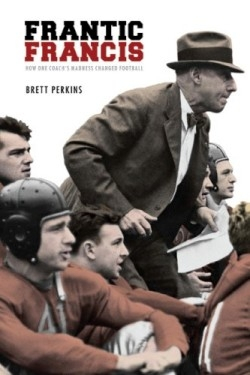Frantic Francis
How One Coach's Madness Changed Football
The names of the legendary head coaches of football yesteryear are indelibly etched into the minds of football fans and into American culture. Halas. Lombardi. Bryant. Rockne. The names evoke an image of a hard-nosed past where players wore only leather helmets for protection and played both offense and defense.
Francis Schmidt is enshrined in the College Football Hall of Fame, but his is not a familiar name, even among football aficionados. In Frantic Francis, the first book to feature Schmidt as its subject, author Brett Perkins convincingly makes the case that Schmidt’s name should be better known.
Schmidt’s football coaching career was nomadic, much like his early life when his father, a professional photographer, moved the family all across the Dust Bowl. Schmidt was an accomplished athlete in many sports and had a mind that never stopped racing; he particularly liked football because of the endless potential to dream up plays. Schmidt went on to play football for the University of Nebraska, and graduated with a law degree in 1907. Fate intervened, and he returned home to Kansas to care for his ailing mother. This led to a volunteer position as the coach of a local high school team, and began a journey that would lead him from the obscurity of the Plains to one of college football’s most prestigious jobs.
What Schmidt instituted at that first job, and at subsequent higher profile coaching positions, was a complex offense the likes of which had never been seen. Football in the early part of the twentieth century was an ultra-conservative game. The forward pass was rarely used, and teams usually didn’t score more than a combined twenty points in a game. Schmidt, however, concocted a style that sportswriters would come to call “razzle-dazzle,” using double-reverses, hidden ball plays, and other forms of trickery. What is more, Schmidt’s teams would routinely run twenty to thirty pass plays per game, when the norm was less than ten.
This led to lots of offensive fireworks for Schmidt’s teams, and a lot of wins. It attracted the attention of several collegiate programs, from the University of Tulsa, Schmidt’s first big break, to the University of Arkansas and Texas Christian University. Finally, in 1934, Schmidt was offered one of the most prestigious jobs in college football: head coach for Ohio State University.
Schmidt’s genius was also his downfall, however. Perkins paints a picture of Schmidt as a near-zealot whose mind never stopped racing and plotting. And Schmidt didn’t have the word “off-season” in his vocabulary. He asked his players to commit up to ten months per year to football; since Schmidt had a playbook about ten times larger than average, his players had to come into work on new plays during the rest season. This led to player fatigue and was a critical part of Schmidt’s downfall in later years at Ohio State.
Perkins does a fine job of explaining how Schmidt came to influence many future offensive-minded coaches and helped change the game from a plodding, low-scoring affair to the immensely popular spectator sport it is now. Schmidt is a unique character in the history of football and his story has now finally been told.
Reviewed by
Bryan Yurcan
Disclosure: This article is not an endorsement, but a review. The publisher of this book provided free copies of the book to have their book reviewed by a professional reviewer. No fee was paid by the publisher for this review. Foreword Reviews only recommends books that we love. Foreword Magazine, Inc. is disclosing this in accordance with the Federal Trade Commission’s 16 CFR, Part 255.

